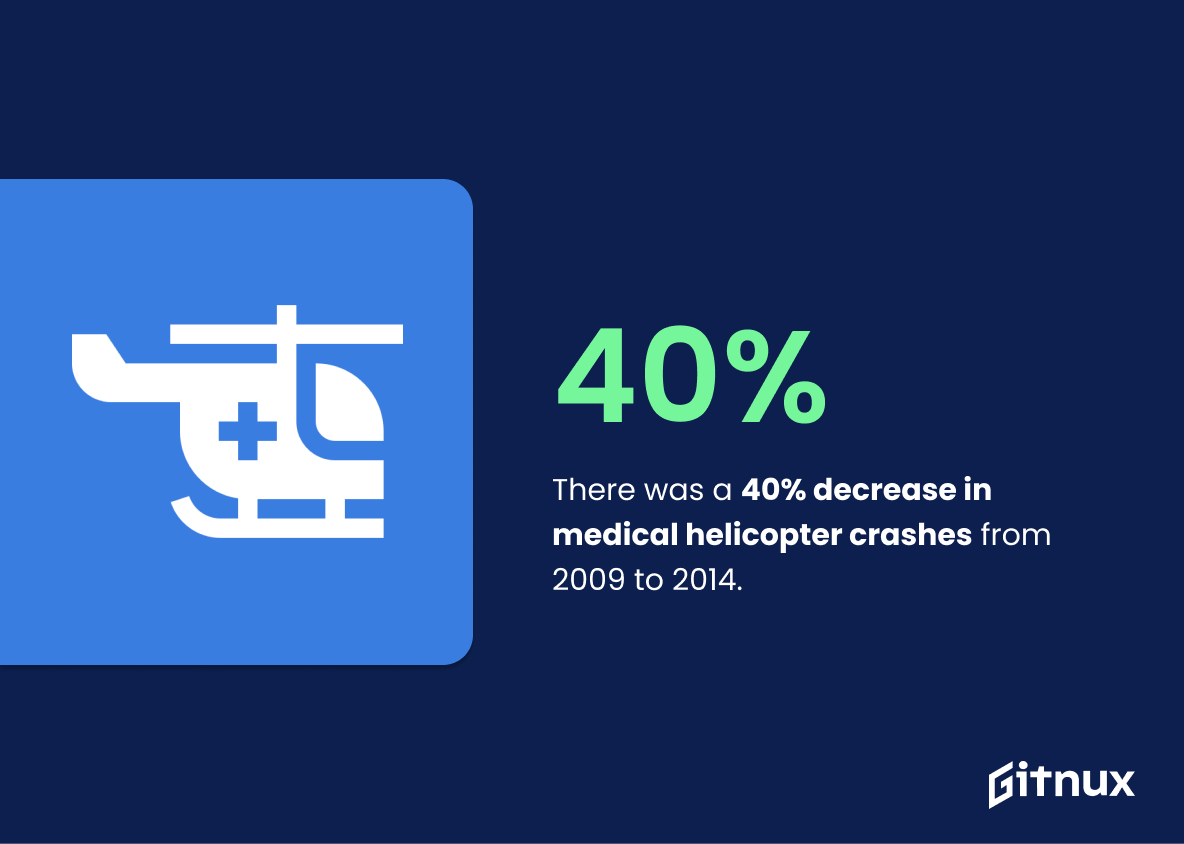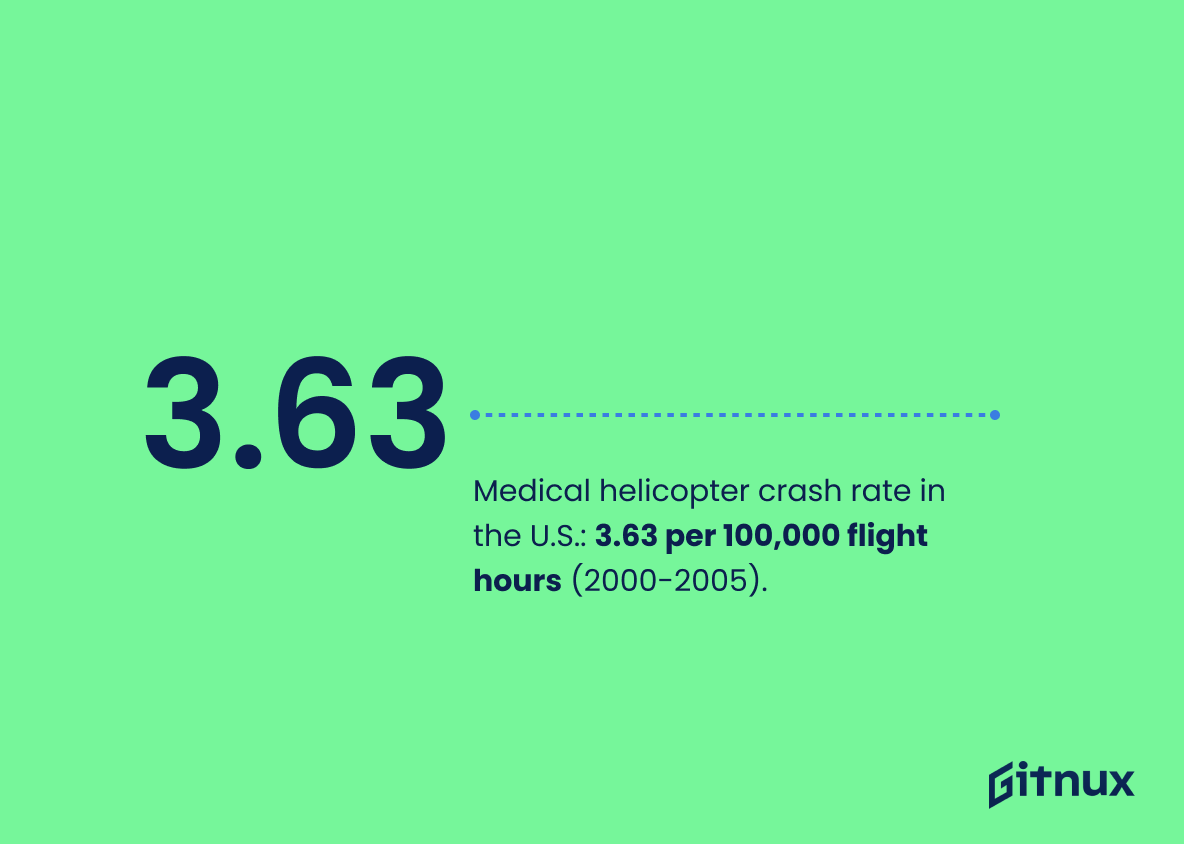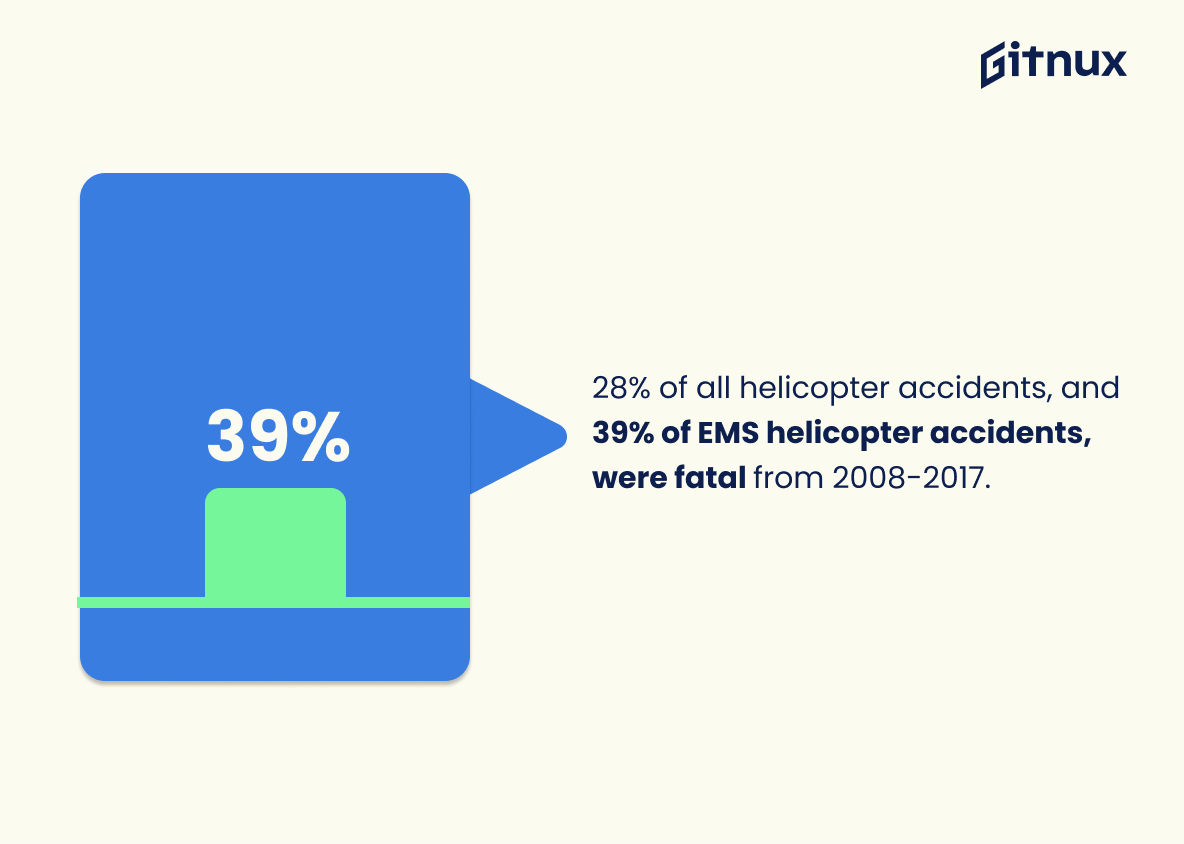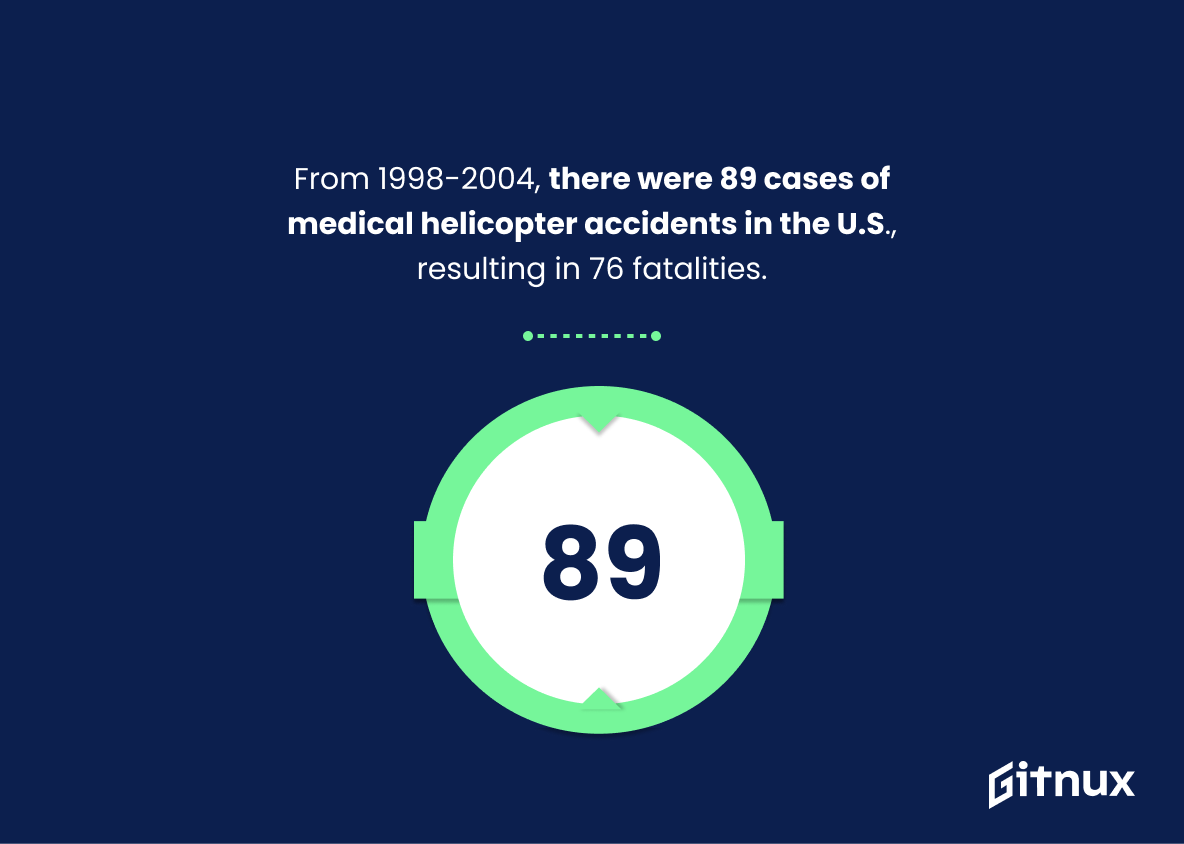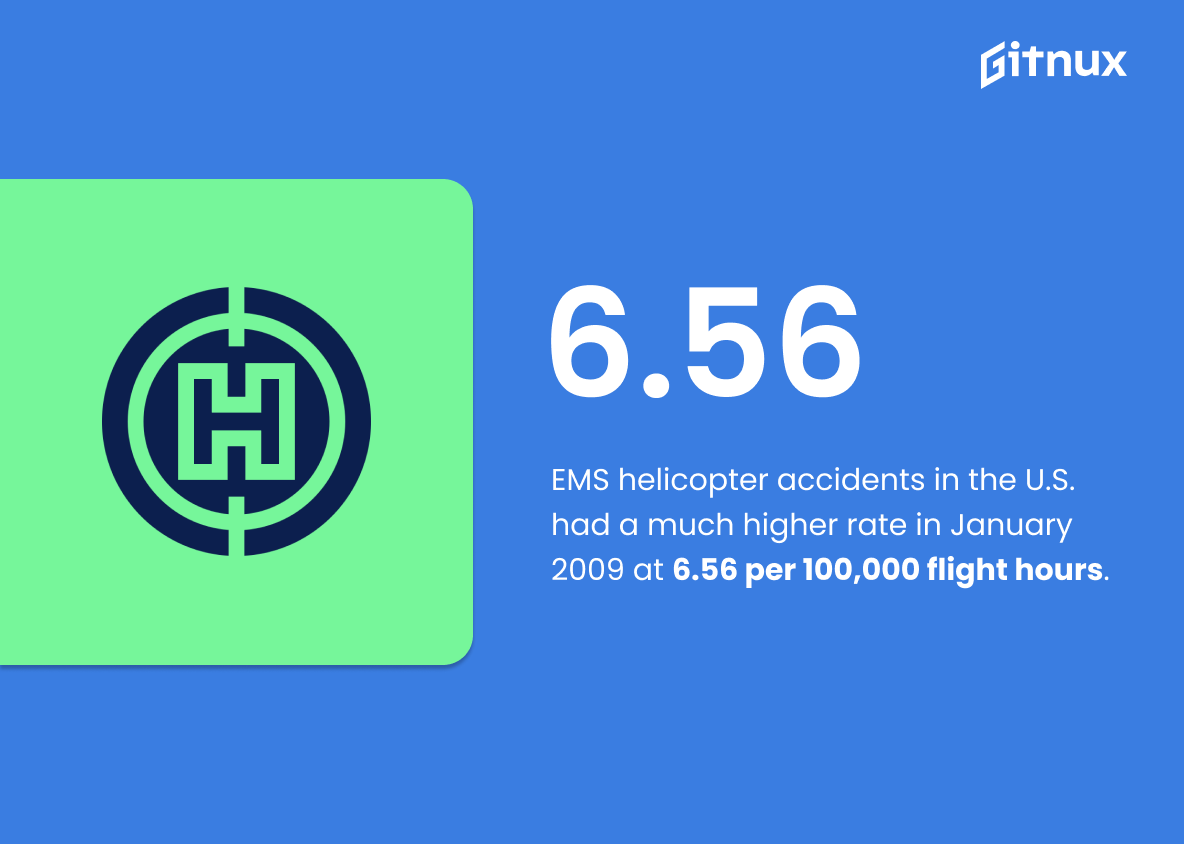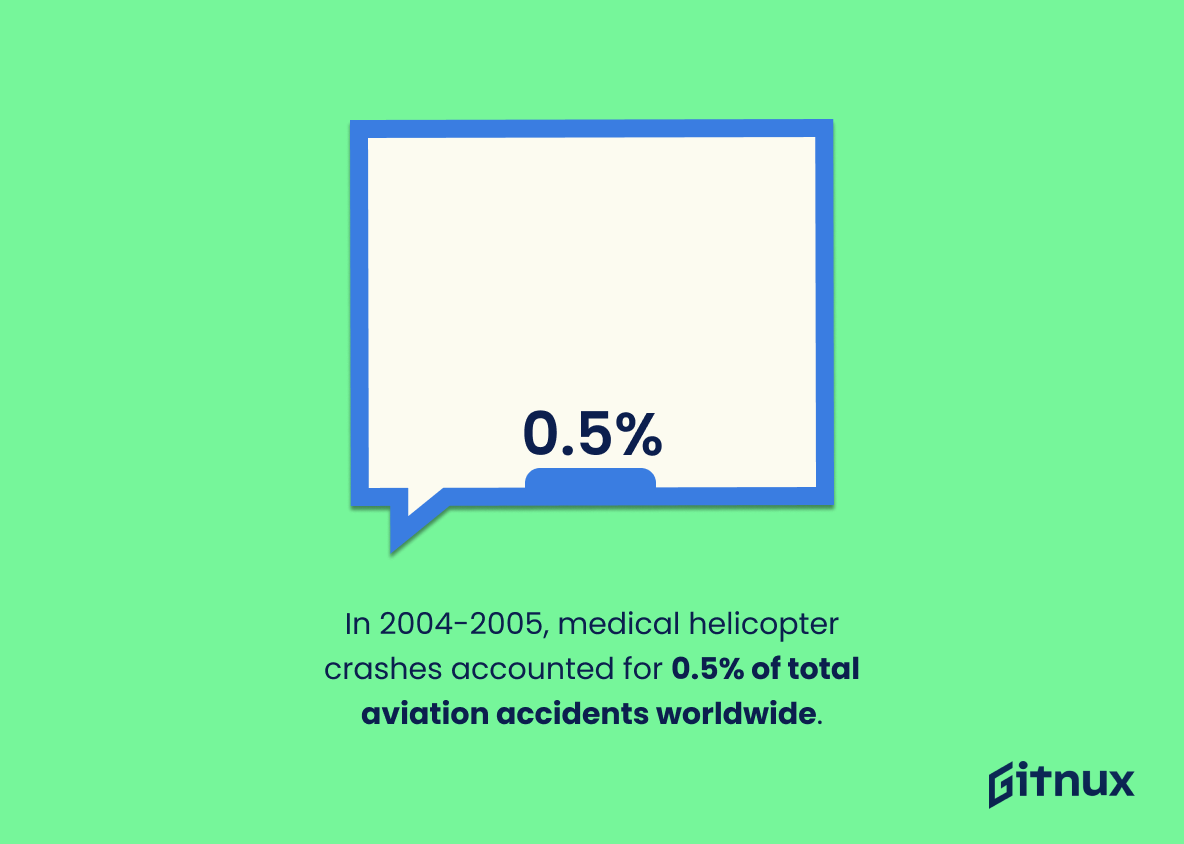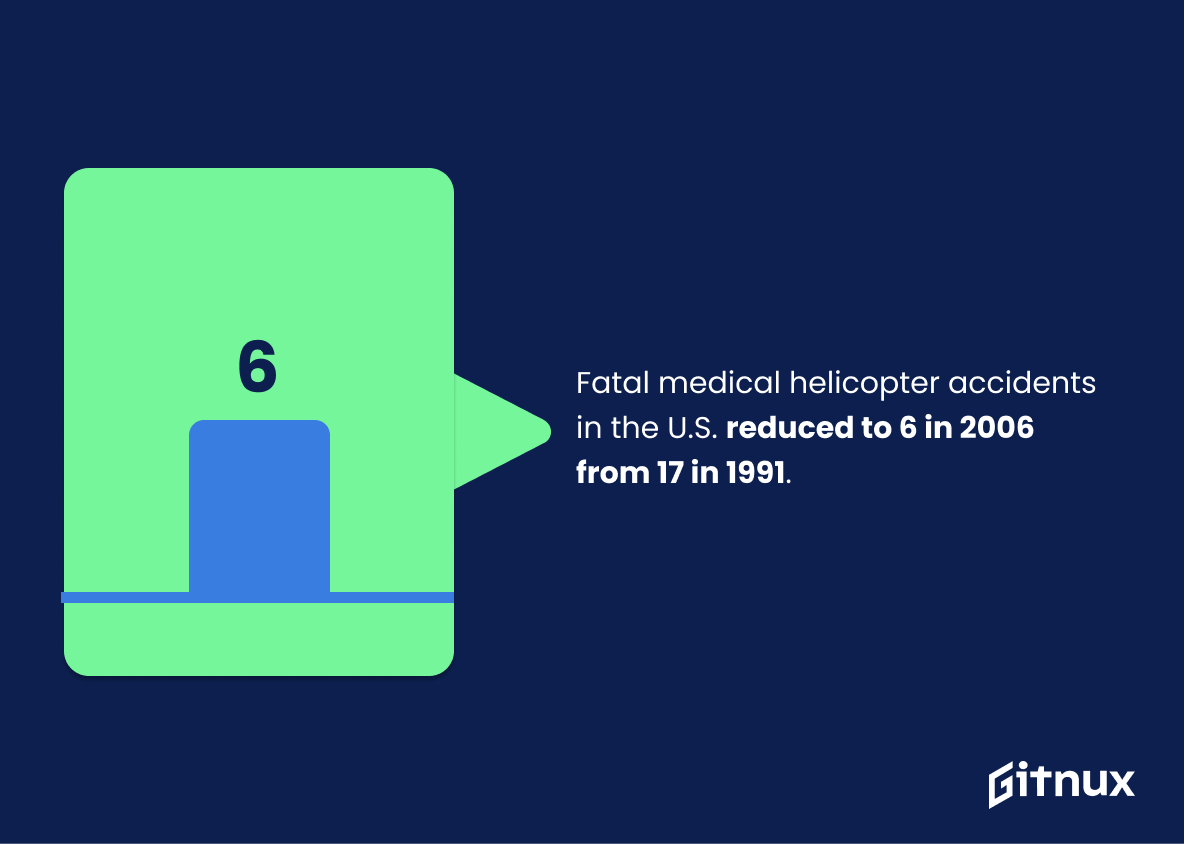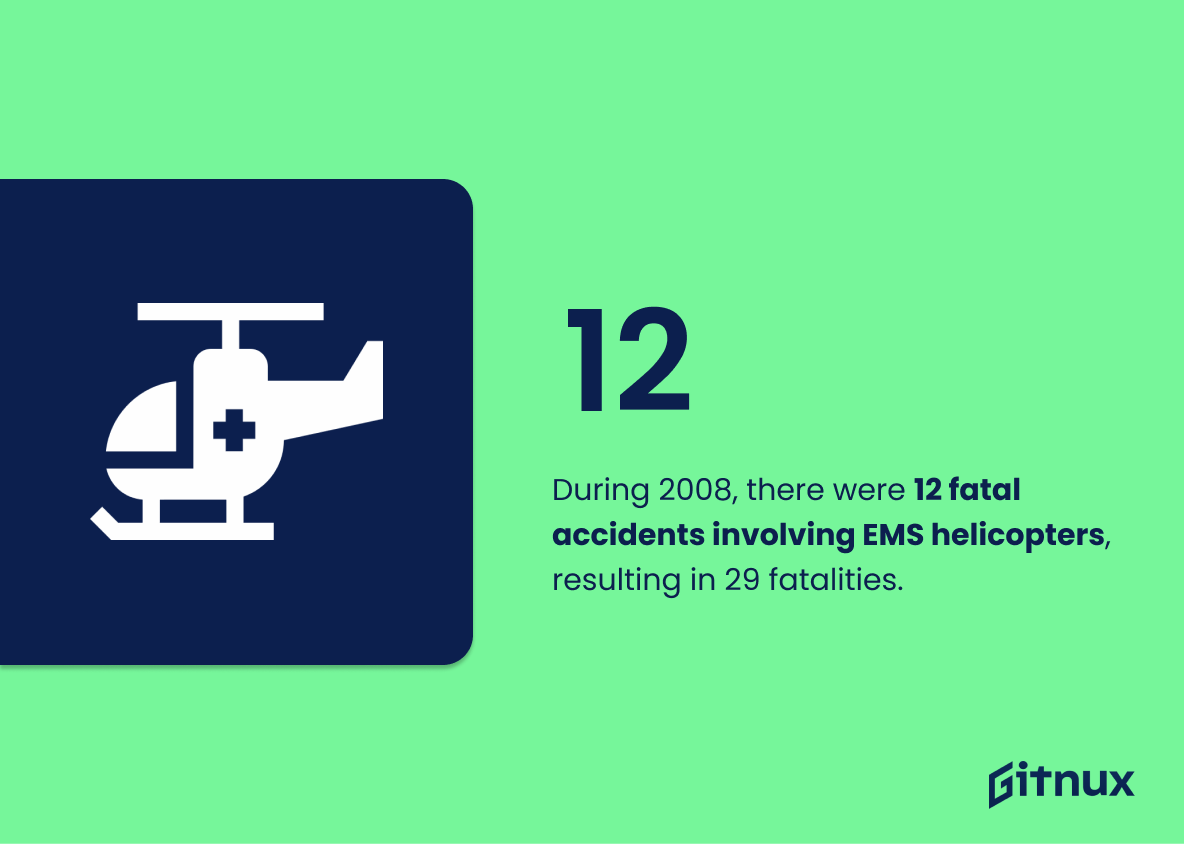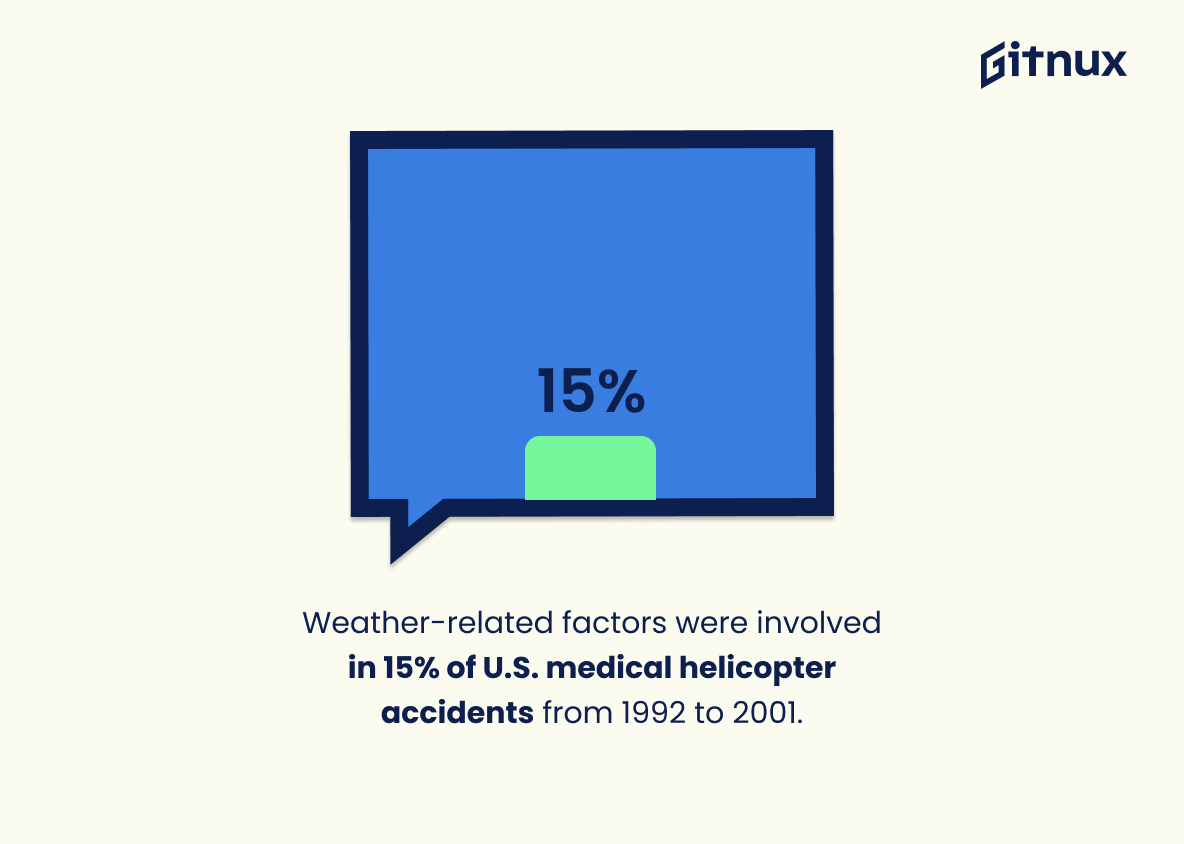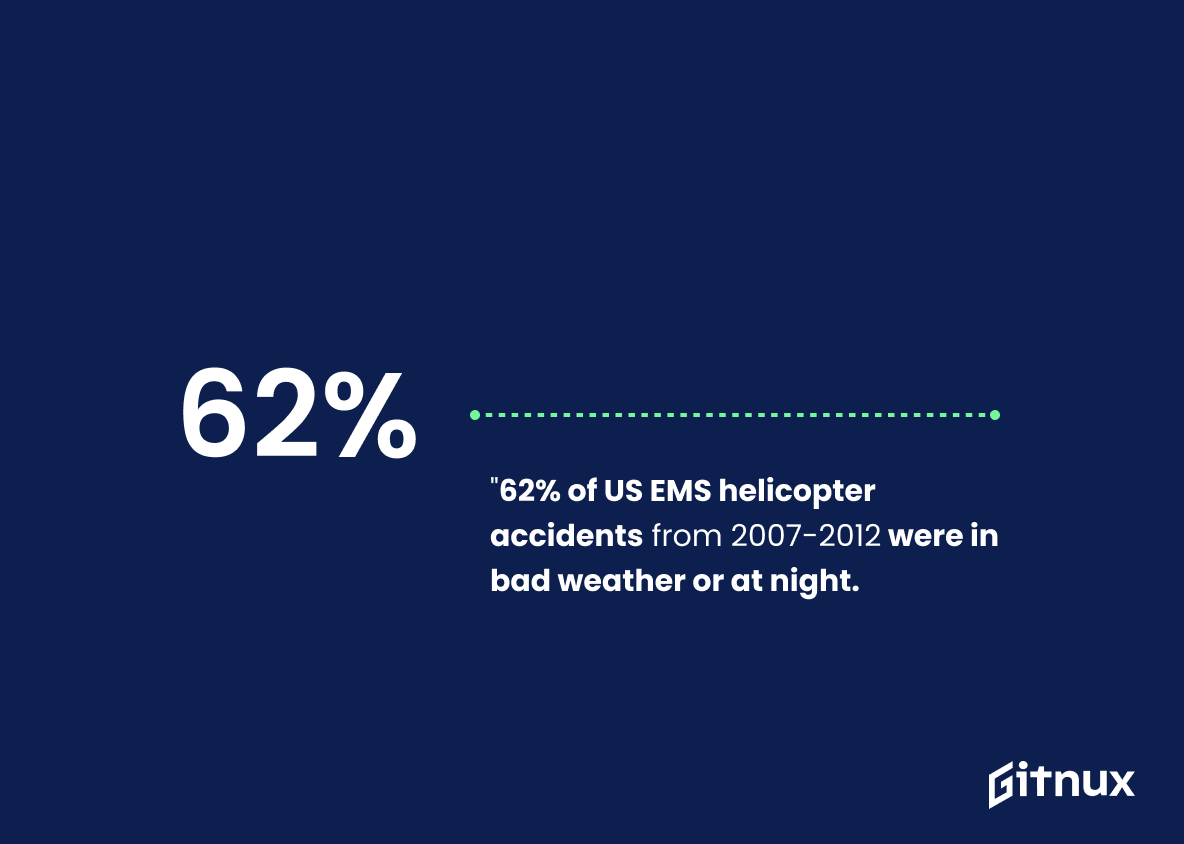Medical helicopter crashes are a serious safety concern, with 263 accidents occurring in the United States between 1998 and 2017. On average, these incidents result in 2.6 fatalities per year. In fact, from 1972 to 2002 there were 202 medical helicopter crashes reported across the country alone. However, recent data shows that there has been a 40% decrease in medical helicopter crash rates since 2009-2014 due to improved safety measures being implemented by industry professionals.
In addition to this decline of overall accident rate, research also indicates that 91% of all medical helicopters crashes occur during “en route” phase of flight while 84 cases occurred between 1995 and 2005 resulting in 76 fatalities over those 10 years period as well as 3.63 per 100000 flight hours from 2000-2005 according to another study conducted on trends for such events within U.S.. Furthermore 28 percent total Helicopter Accidents were fatal whereas 39 percent EMS Helicopter Accidents were fatal from 2008 -2017 . Additionally 29 %of 309 US Medical Helicopters Crashes happened at night time (from 1983 – 2015) , 0 5 % accounted for world wide aviation accidents (2004–2005 ) & 160 US Medical Heli Copter Crash resulted 187 Fatalities(1970–2009). Mechanical failure was only responsible for 5 %of 1991–2010 Medial heli copter Crashes & 15 Percent weather related factors involved 1992-2001 US mediacal helicoptor accidnets . 62 Percent EMS helicoptecrash occured IMC or NVMC 2007 -2012 where as 2010 – 2019 saw 29 Fatal Global Mediacl Helicopptor Accident Rate .
Medical Helicopter Crash Statistics Overview
There was a 40% decrease in medical helicopter crashes from 2009 to 2014.
This statistic is a testament to the progress that has been made in the realm of medical helicopter safety. It shows that the efforts to reduce the number of medical helicopter crashes have been successful, and that the industry is taking steps in the right direction. This is an encouraging sign for those who rely on medical helicopters for transportation and medical care.
91% of medical helicopter crashes occur during the “en route” phase of flight.
This statistic is a crucial indicator of the dangers of medical helicopter flights, as it highlights the fact that the majority of crashes occur during the most hazardous part of the journey. It is essential to understand this statistic in order to better understand the risks associated with medical helicopter flights and to take the necessary steps to reduce the likelihood of a crash.
The incidence of medical helicopter crashes in the U.S. was 3.63 per 100,000 flight hours from 2000 to 2005.
This statistic is a crucial indicator of the safety of medical helicopter flights in the U.S. during the period of 2000 to 2005. It provides a snapshot of the risk of a medical helicopter crash during that time, and can be used to compare the safety of medical helicopter flights to other forms of transportation. This statistic is essential for understanding the risks associated with medical helicopter flights and can be used to inform decisions about the safety of such flights.
From 2008-2017, 28% of total helicopter accidents were fatal, while 39% of EMS helicopter accidents were fatal in the same time span.
This statistic is a stark reminder of the dangers of medical helicopter transport. It highlights the fact that, while helicopter accidents are already a serious risk, EMS helicopter accidents are even more likely to be fatal. This is an important point to consider when weighing the risks and benefits of medical helicopter transport.
From 1998-2004, there were 89 cases of medical helicopter accidents in the U.S., resulting in 76 fatalities.
This statistic is a stark reminder of the dangers of medical helicopter travel. It highlights the fact that, despite the best efforts of medical professionals, these accidents can still occur, resulting in tragic loss of life. It serves as a warning to those who may be considering medical helicopter transport, and emphasizes the importance of safety protocols and procedures.
The January 2009 aviation accident rate for EMS helicopters in the U.S. was 6.56 per 100,000 flight hours, much higher than the overall industry or other civil helicopter fleets, such as offshore oil support.
This statistic is a stark reminder of the dangers of medical helicopter flights. It highlights the fact that EMS helicopters have a much higher accident rate than other civil helicopter fleets, such as offshore oil support, and that the risk of a medical helicopter crash is significantly higher than the overall industry. This is an important point to consider when discussing medical helicopter crash statistics, as it emphasizes the need for increased safety measures and better training for medical helicopter pilots.
In 2004-2005, medical helicopter crashes accounted for 0.5% of total aviation accidents worldwide.
This statistic is a powerful reminder of the risks associated with medical helicopter transport. It highlights the fact that, despite the life-saving potential of these aircraft, they are still subject to the same dangers as other forms of aviation. This statistic serves as a stark reminder that medical helicopter crashes are a real and present danger, and that safety must remain a top priority for those involved in the industry.
As of 2010, there have been more than 200 EMS helicopter accidents in the U.S. since 1980, with over 200 fatalities.
This statistic is a stark reminder of the dangers of medical helicopter transport. It highlights the fact that, despite advances in safety technology, these accidents still occur with alarming frequency, resulting in over 200 fatalities since 1980. This serves as a warning to those who rely on medical helicopters for transport, and underscores the importance of taking all necessary precautions to ensure the safety of those on board.
Fatal medical helicopter accidents in the U.S. reduced to 6 in 2006 from 17 in 1991.
This statistic is a testament to the progress made in the safety of medical helicopter transportation. It shows that the efforts to reduce the number of fatal accidents have been successful, with a decrease of over 65% in the span of 15 years. This is an encouraging sign for those who rely on medical helicopters for transportation, as it indicates that the risk of a fatal accident is much lower than it was in the past.
Mechanical failure was a factor in only 5% of medical helicopter accidents from 1991 to 2010.
This statistic is significant in the context of medical helicopter crash statistics because it indicates that mechanical failure is not a major contributing factor to these accidents. This suggests that other factors, such as pilot error, weather conditions, or other external factors, are more likely to be the cause of medical helicopter crashes. This information can be used to inform safety protocols and procedures to help reduce the risk of future accidents.
During 2008, there were 12 fatal accidents involving EMS helicopters, resulting in 29 fatalities.
This statistic is a stark reminder of the dangers of medical helicopter transport. It highlights the fact that, despite the best efforts of the pilots and medical personnel, these accidents can still occur, resulting in tragic loss of life. It serves as a reminder that medical helicopter transport should not be taken lightly, and that safety should always be the top priority.
Weather-related factors were involved in 15% of U.S. medical helicopter accidents from 1992 to 2001.
This statistic is a stark reminder of the dangers posed by inclement weather when it comes to medical helicopter accidents. It highlights the importance of taking extra precautions when flying in adverse weather conditions, as even a small mistake can have catastrophic consequences. This statistic is a call to action for medical helicopter pilots and operators to take extra care when flying in hazardous weather, and to ensure that all safety protocols are followed to the letter.
From 2007-2012, 62% of EMS helicopter accidents in the U.S. occurred during instrument meteorological conditions (IMC) or night visual meteorological conditions (NVMC).
This statistic is a stark reminder of the dangers of flying medical helicopters in instrument meteorological conditions (IMC) or night visual meteorological conditions (NVMC). It highlights the importance of taking extra precautions when operating in these conditions, as they are more likely to lead to accidents. This statistic is a call to action for medical helicopter operators to ensure they are taking all necessary safety measures when flying in IMC or NVMC.
Conclusion
The statistics presented in this blog post demonstrate that medical helicopter crashes are a serious issue, with 263 accidents occurring in the U.S. between 1998 and 2017 alone. On average, these crashes result in 2.6 fatalities per year, while 91% of them occur during the “en route” phase of flight. Furthermore, there has been an overall decrease in medical helicopter crash rates since 2009 due to improved safety measures; however they still remain higher than other civil helicopters such as offshore oil support fleets or general aviation aircrafts at 6.56 per 100 000 flight hours for EMS helicopters from 2008-2017 compared to 0.7 for GA aircrafts over the same period . It is clear that further efforts must be made to reduce medical helicopter accident rates even more so that patients can receive safe transport when needed without fear of injury or death caused by preventable accidents
References
0. – https://www.www.gao.gov
1. – https://www.www.healthleadersmedia.com
2. – https://www.www.faa.gov
3. – https://www.books.google.com
4. – https://www.www.foxnews.com
5. – https://www.asrs.arc.nasa.gov
6. – https://www.www.researchgate.net
7. – https://www.pubmed.ncbi.nlm.nih.gov
8. – https://www.ntrs.nasa.gov
9. – https://www.www.ncbi.nlm.nih.gov
10. – https://www.www.ntsb.gov
